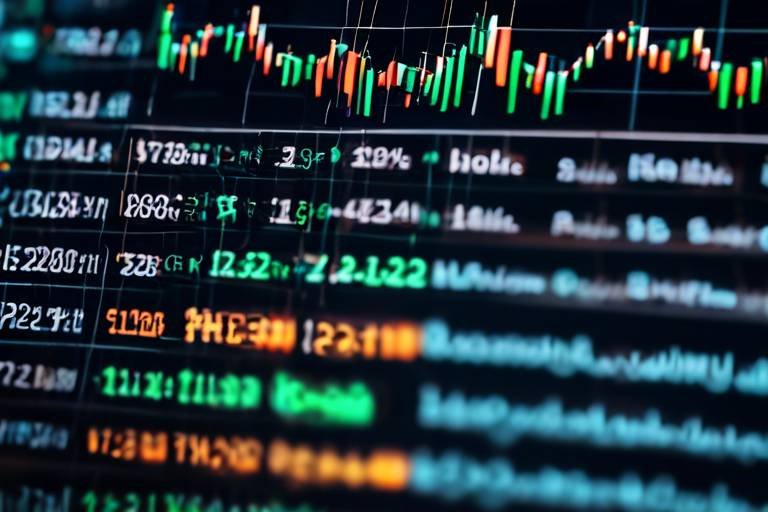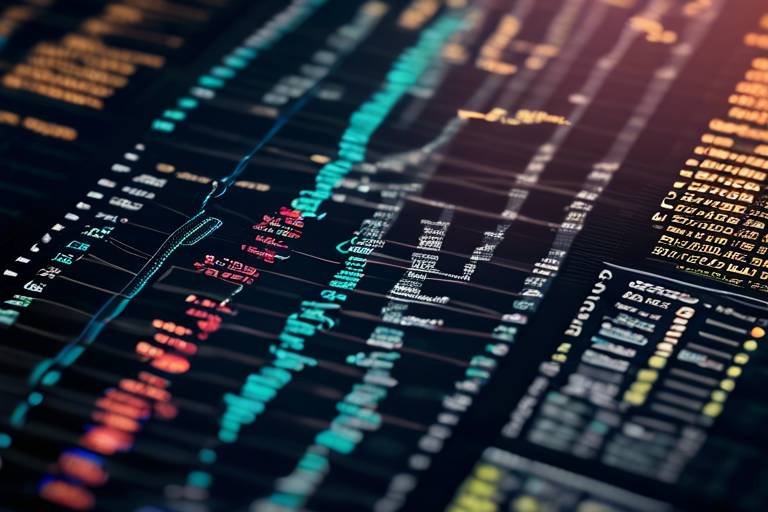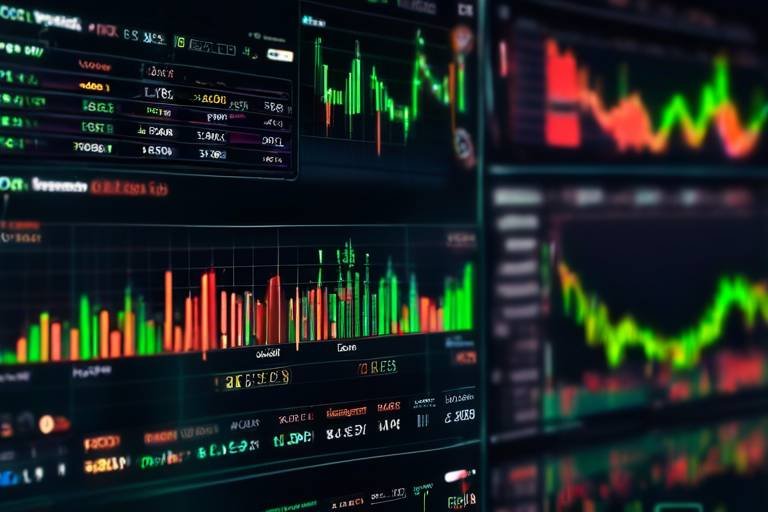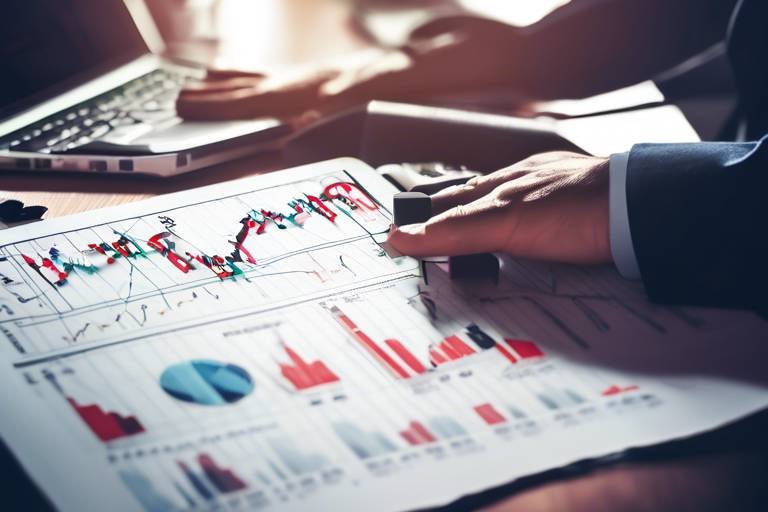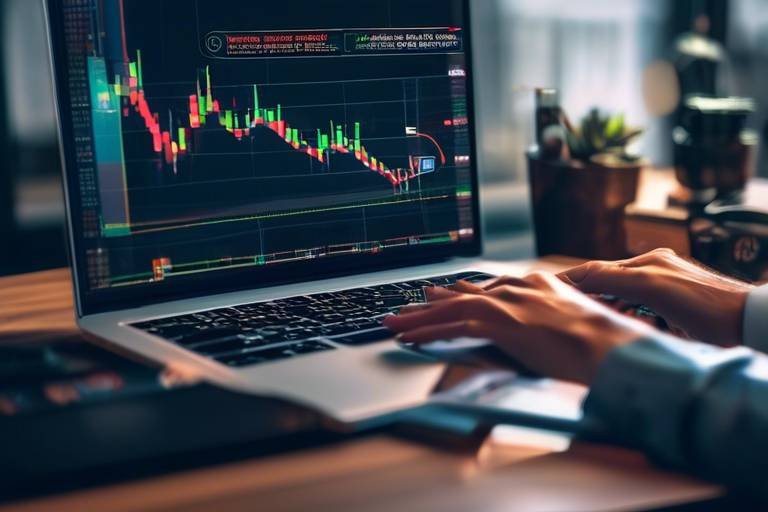How to Read Crypto Market Trends Using Technical Analysis
In the fast-paced world of cryptocurrency, understanding market trends is not just beneficial—it's essential. With the volatility that characterizes digital currencies, traders need a reliable method to predict price movements and make informed decisions. This is where technical analysis comes into play. By examining historical price data and trading volumes, technical analysis provides insights that can help traders navigate the often tumultuous waters of the crypto market.
Imagine trying to predict the weather without looking at past patterns—it's nearly impossible! Similarly, technical analysis allows traders to look at past price movements and volumes to forecast future trends. It's like having a crystal ball that, while not infallible, can give you a significant edge. The principles of technical analysis are rooted in the belief that all market information is reflected in the price, and that prices move in trends. Therefore, understanding these trends is crucial for anyone looking to trade cryptocurrencies successfully.
In this article, we will explore the essential aspects of technical analysis, including key indicators, chart patterns, and volume analysis, to equip you with the tools needed to interpret trends effectively. Whether you are a seasoned trader or a novice just starting, mastering these concepts will enhance your ability to make informed trading decisions and improve your overall trading strategy.
At its core, technical analysis is about studying price movements and trading volumes over time. It helps traders identify patterns that can signal potential price changes. The significance of technical analysis in trading cannot be overstated. By relying on data rather than emotions, traders can make more rational decisions, reducing the likelihood of impulsive trades driven by fear or greed.
One of the primary advantages of technical analysis is its applicability across various time frames. Whether you're looking at minute-by-minute price changes or long-term trends, the principles of technical analysis remain consistent. This versatility makes it a valuable tool for traders of all levels.
Indicators are the bread and butter of technical analysis. They help traders decipher the market's behavior and predict future price movements. Some of the most commonly used indicators include:
- Moving Averages
- Relative Strength Index (RSI)
- MACD (Moving Average Convergence Divergence)
Each of these indicators serves a unique purpose and can provide valuable insights when used correctly. In the following sections, we will dive deeper into moving averages and RSI, two of the most popular indicators among traders.
Moving averages are essential tools for identifying trends over time. They smooth out price data, making it easier to see the overall direction of the market. There are two main types of moving averages that traders use:
The Simple Moving Average (SMA) is calculated by averaging the prices over a specific period. For example, a 10-day SMA adds up the closing prices of the last ten days and divides by ten. This average helps traders identify the general trend of the market. When the price is above the SMA, it indicates an uptrend, while a price below the SMA suggests a downtrend.
On the other hand, the Exponential Moving Average (EMA) gives more weight to recent prices, making it more responsive to new information. This feature can be particularly advantageous in volatile markets like cryptocurrencies, where rapid price changes are common. Traders often use the EMA to spot potential reversals or continuations in the market trend.
The RSI is a momentum oscillator that measures the speed and change of price movements. It ranges from 0 to 100, with values above 70 indicating that an asset is overbought, and values below 30 suggesting it is oversold. This information can help traders make decisions about when to enter or exit a position. For instance, if the RSI shows an overbought condition, it might be a signal to sell, while an oversold condition could indicate a buying opportunity.
Recognizing chart patterns is another critical aspect of technical analysis. Patterns like head and shoulders, triangles, and flags can provide insights into potential future price movements. For example, the head and shoulders pattern often signals a reversal in trend, while triangles and flags indicate continuation patterns that suggest the current trend will persist.
Volume analysis complements price movements by indicating the strength of a trend. High volume during a price increase suggests strong buying interest, while high volume during a price decrease indicates strong selling pressure. Understanding volume can enhance your trading decisions, helping you confirm whether a trend is likely to continue or reverse.
While technical analysis is powerful, combining it with fundamental analysis can provide a more comprehensive view of the market. Fundamental analysis involves examining the underlying factors that influence an asset's value, such as news events, technological advancements, and regulatory changes. By balancing both approaches, traders can make more informed decisions and improve their trading outcomes.
Creating a robust trading strategy involves using technical analysis effectively. Start by defining your goals, risk tolerance, and preferred trading style. From there, you can incorporate key indicators and chart patterns into your strategy, continually refining it based on your experiences and market conditions.
Even experienced traders can fall into traps when relying on technical analysis. Common mistakes include:
- Overtrading based on short-term fluctuations
- Ignoring fundamental factors that can impact prices
- Failing to adapt strategies to changing market conditions
By being aware of these pitfalls and learning from them, you can enhance your trading experience and increase your chances of success.
1. What is the best time frame for technical analysis?
There is no one-size-fits-all answer, as the best time frame depends on your trading style. Day traders may prefer shorter time frames, while long-term investors might focus on daily or weekly charts.
2. Can technical analysis predict market crashes?
While technical analysis can indicate potential downturns, it cannot predict market crashes with certainty. It's essential to combine technical analysis with other methods for a more comprehensive view.
3. How do I choose the right indicators?
Start with a few key indicators that align with your trading goals. As you gain experience, you can experiment with additional indicators to see what works best for you.
4. Is technical analysis suitable for all cryptocurrencies?
Yes, technical analysis can be applied to any asset with historical price data, including cryptocurrencies. However, the effectiveness of specific indicators may vary based on the asset's volatility and market behavior.

Understanding Technical Analysis
When diving into the exciting world of cryptocurrency trading, one of the first concepts you'll encounter is technical analysis. So, what exactly is it? In simple terms, technical analysis is the practice of evaluating price movements and trading volumes to forecast future price changes. Imagine trying to predict the weather by looking at past weather patterns; that’s essentially what you’re doing with crypto prices. By analyzing historical data, traders aim to identify trends and make informed decisions about when to buy or sell.
The significance of technical analysis in trading cannot be overstated. It provides a structured approach to making decisions in a market that can often feel chaotic and unpredictable. Instead of relying solely on gut feelings or news headlines, traders can use charts and indicators to guide their strategies. This method can help you avoid emotional trading, which is often a recipe for disaster. Remember, in the world of crypto, it's not just about what you know; it's also about how you interpret the data at your disposal.
One of the key principles of technical analysis is the idea that market psychology plays a significant role in price movements. Traders often react similarly to news and events, creating patterns that can be analyzed. For instance, when a cryptocurrency hits a new high, many traders might feel the urge to buy in, pushing the price even higher. Conversely, when prices drop, fear can set in, leading to panic selling. Understanding these psychological factors can give you an edge in predicting market trends.
Moreover, technical analysis is not just a standalone tool; it works best when combined with other analytical methods. While technical analysis focuses on price movements, integrating it with fundamental analysis—which examines the underlying factors affecting a cryptocurrency's value—can provide a more rounded view of the market. By understanding both the technical indicators and the fundamental value of a coin, traders can develop a more robust trading strategy.
In conclusion, technical analysis is a vital skill for anyone looking to navigate the cryptocurrency market effectively. It allows traders to make data-driven decisions rather than relying on speculation. As you delve deeper into this field, you'll discover various tools and techniques that can enhance your trading experience. Remember, the more you understand the market dynamics, the better equipped you'll be to seize opportunities as they arise.

Key Indicators in Technical Analysis
When diving into the world of cryptocurrency, understanding the key indicators in technical analysis can be your secret weapon. These indicators are like the compass guiding you through the volatile seas of the crypto market. They help you make sense of price movements and trading volumes, allowing you to forecast potential future price changes. Let’s explore some of the most commonly used indicators that can enhance your trading strategy.
One of the primary indicators is the Moving Average. Think of moving averages as a way to smooth out the noise of price fluctuations. By averaging prices over a specific period, they help you identify trends more clearly. There are two main types of moving averages that traders frequently use: the Simple Moving Average (SMA) and the Exponential Moving Average (EMA). Each serves its purpose in different trading scenarios.
The SMA is calculated by taking the average of a set of prices over a defined period. For instance, if you’re looking at a 10-day SMA, you would add up the closing prices from the last ten days and then divide by ten. This gives you a single value that represents the average price over that timeframe. Traders often use the SMA to identify whether a cryptocurrency is in an upward or downward trend. However, one downside is that it can lag behind the market, as it gives equal weight to all prices in the period.
On the other hand, the EMA gives more weight to recent prices, making it more responsive to new information. This characteristic is particularly useful for traders who want to capture trends quickly. For example, if a cryptocurrency experiences a sudden spike in price, the EMA will reflect that change faster than the SMA. This can be crucial for making timely trading decisions. Many traders use both moving averages together to create a crossover strategy, where they buy or sell based on the interaction between the two averages.
Another essential indicator is the Relative Strength Index (RSI). Imagine the RSI as a speedometer for price movements. It measures the speed and change of price movements on a scale from 0 to 100. An RSI above 70 typically indicates that an asset is overbought, while an RSI below 30 suggests that it is oversold. This can be an invaluable tool for traders looking to identify potential reversal points in the market. By keeping an eye on the RSI, you can better understand when it might be wise to enter or exit a trade.
To summarize the key indicators, here’s a quick reference table:
| Indicator | Type | Description |
|---|---|---|
| Simple Moving Average (SMA) | Trend Indicator | Averages prices over a specific period to identify trends. |
| Exponential Moving Average (EMA) | Trend Indicator | Gives more weight to recent prices for a quicker response to price changes. |
| Relative Strength Index (RSI) | Momentum Indicator | Measures the speed and change of price movements to identify overbought or oversold conditions. |
In conclusion, mastering these key indicators can significantly enhance your ability to read market trends and make informed trading decisions. Remember, while these tools are powerful, they should not be used in isolation. Always consider combining them with other forms of analysis for a more rounded approach to trading.
Q1: What is the best indicator for beginners?
A1: The Simple Moving Average (SMA) is often recommended for beginners as it provides a clear view of trends without being too complex.
Q2: How can I use the RSI effectively?
A2: Use the RSI to identify overbought and oversold conditions. Look for values above 70 or below 30 to signal potential market reversals.
Q3: Should I rely solely on technical indicators for trading?
A3: No, it’s best to combine technical analysis with fundamental analysis for a more comprehensive view of the market.

Moving Averages
Moving averages are like the compass of the trading world, guiding you through the chaotic seas of cryptocurrency price fluctuations. They help traders smooth out the noise of daily price movements, allowing them to see the underlying trend more clearly. By averaging prices over a specific period, moving averages provide insights into the direction of the market, whether it’s bullish or bearish. This is essential for making informed trading decisions. Imagine trying to navigate a stormy ocean without a map; moving averages serve as that map, showing you where the currents are strongest.
There are two primary types of moving averages that traders frequently use: the Simple Moving Average (SMA) and the Exponential Moving Average (EMA). Both have their unique characteristics and applications, and understanding these differences can significantly enhance your trading strategy. Let's dive deeper into each type.
The Simple Moving Average is calculated by adding the closing prices of a cryptocurrency over a specified number of periods and then dividing that sum by the total number of periods. For example, if you're looking at a 10-day SMA, you would take the closing prices of the last 10 days, sum them up, and divide by 10. This straightforward approach provides a clear view of the average price over that timeframe, which can help identify trends.
Traders often look for crossovers between the SMA and the current price. If the price crosses above the SMA, it might indicate a potential buying opportunity, while a crossover below the SMA could signal a selling opportunity. Here’s a simple table to illustrate how the SMA can be calculated:
| Day | Closing Price |
|---|---|
| 1 | $100 |
| 2 | $105 |
| 3 | $102 |
| 4 | $110 |
| 5 | $108 |
| 6 | $107 |
| 7 | $109 |
| 8 | $111 |
| 9 | $115 |
| 10 | $120 |
In this example, to calculate the 10-day SMA, you would add all the closing prices from Day 1 to Day 10 and divide by 10, giving you a clear average that reflects the price trend over that period.
On the other hand, the Exponential Moving Average is a bit more sophisticated. It gives more weight to recent prices, making it more responsive to new information. This means that the EMA reacts faster to price changes compared to the SMA, which can be particularly useful in the fast-paced world of cryptocurrency trading. Imagine the EMA as a quick-thinking friend who always keeps you updated with the latest gossip, while the SMA is like a wise old sage who provides you with a broader perspective.
Traders often prefer the EMA when they want to capture quick price movements, especially in volatile markets. The calculation involves a bit more math, but it’s worth it for the insights it provides. Here’s a quick breakdown of how the EMA is calculated:
- Choose a period (e.g., 10 days).
- Calculate the SMA for that period.
- Determine the multiplier: Multiplier 2 / (N + 1), where N is the number of periods.
- Apply the formula: EMA (Current Price - Previous EMA) x Multiplier + Previous EMA.
By understanding and utilizing both the SMA and EMA, traders can develop a more nuanced approach to analyzing market trends. Whether you're a seasoned trader or just starting, incorporating moving averages into your strategy can significantly enhance your ability to make informed decisions.
Q: What are moving averages used for in trading?
A: Moving averages are primarily used to identify trends and potential reversal points in the market. They help traders smooth out price data to make better-informed decisions.
Q: How do I choose the right period for a moving average?
A: The right period depends on your trading strategy. Shorter periods (like 10 days) are more sensitive to price changes, while longer periods (like 50 or 200 days) provide a broader view of the trend.
Q: Can moving averages predict future prices?
A: While moving averages can help identify trends and potential price movements, they cannot predict future prices with certainty. They should be used in conjunction with other analysis tools.

Simple Moving Average (SMA)
The is one of the most fundamental tools in the realm of technical analysis, and for good reason! It provides a clear and concise way to gauge the overall direction of a cryptocurrency's price movement over a specific period. Essentially, the SMA is calculated by taking the average of a set number of closing prices over a designated timeframe. For instance, if you're looking at a 10-day SMA, you would sum the closing prices of the last 10 days and divide that total by 10. This gives you a smoothed-out view of the price, filtering out the noise and volatility that can often confuse traders.
Now, why is this important? Imagine you're trying to navigate through a dense fog. The SMA acts like a lighthouse, guiding you through the murky waters of price fluctuations. By observing the SMA, traders can identify whether a cryptocurrency is in an uptrend or downtrend. When the price is consistently above the SMA, it suggests a bullish trend, while prices below the SMA may indicate a bearish sentiment.
To illustrate this further, let's take a look at a simple calculation example:
| Day | Closing Price |
|---|---|
| 1 | $100 |
| 2 | $105 |
| 3 | $102 |
| 4 | $108 |
| 5 | $110 |
| 6 | $107 |
| 7 | $111 |
| 8 | $115 |
| 9 | $120 |
| 10 | $125 |
In this example, to calculate the 10-day SMA, you would add up the closing prices from Day 1 to Day 10:
Total $100 + $105 + $102 + $108 + $110 + $107 + $111 + $115 + $120 + $125 $1,083 10-Day SMA Total / 10 $1,083 / 10 $108.30
So, the 10-day SMA is $108.30. This means that if the current price is above this value, it could indicate a potential buying opportunity, while a price below this level might suggest a selling point. However, keep in mind that the SMA is a lagging indicator, which means it reacts to price changes rather than predicts them. Therefore, it's crucial to combine it with other indicators for a more robust trading strategy.
In summary, the SMA is a powerful yet straightforward tool in the trader's arsenal. By understanding how to calculate and interpret the SMA, you can make more informed decisions and navigate the often turbulent waters of the cryptocurrency market.
- What is the difference between SMA and EMA? The main difference lies in the weighting of prices; the SMA gives equal weight to all prices, while the Exponential Moving Average (EMA) gives more weight to recent prices.
- How often should I calculate the SMA? It depends on your trading strategy; some traders calculate it daily, while others may use weekly or monthly averages.
- Can SMA predict future prices? While SMA helps identify trends, it does not predict future prices. It should be used in conjunction with other indicators for better accuracy.

Exponential Moving Average (EMA)
The is a powerful tool in the arsenal of traders, especially when navigating the fast-paced world of cryptocurrency. Unlike the Simple Moving Average (SMA), which treats all price data equally, the EMA gives greater weight to more recent prices. This characteristic allows the EMA to respond more swiftly to price changes, making it an essential indicator for traders who want to stay ahead of market trends.
To calculate the EMA, you need to follow a specific formula that incorporates the previous EMA value and the current price. The calculation can seem a bit complex at first, but it essentially boils down to this: the EMA is calculated by taking the current price, multiplying it by a weighting multiplier, and then adding it to the previous EMA multiplied by (1 - weighting multiplier). The formula looks like this:
EMA (Current Price x Multiplier) + (Previous EMA x (1 - Multiplier))
Where the Multiplier is determined by the number of periods you wish to analyze. For example, for a 10-day EMA, the multiplier would be:
Multiplier 2 / (N + 1)
Where N is the number of days (in this case, 10). Thus, the multiplier for a 10-day EMA would be 0.1818. This means that the most recent price has a greater influence on the EMA compared to older prices, which is particularly useful during volatile market conditions.
One of the key benefits of using the EMA is its ability to help traders identify potential trends. For instance, when the EMA line crosses above the price chart, it may signal a bullish trend, suggesting that it might be a good time to consider buying. Conversely, when the EMA line crosses below the price chart, it may indicate a bearish trend, prompting traders to think about selling or shorting their positions.
In practice, many traders use the EMA in conjunction with other indicators to confirm trends and make more informed decisions. For example, combining the EMA with the Relative Strength Index (RSI) can provide a clearer picture of market momentum, allowing traders to spot potential entry and exit points with greater accuracy.
It's also worth noting that different EMAs can be used for various time frames, such as short-term (like the 5-day or 10-day EMA) or long-term (like the 50-day or 200-day EMA). This flexibility allows traders to tailor their strategies based on their trading style and risk tolerance.
In summary, the Exponential Moving Average is more than just a number on a chart; it’s a dynamic tool that can help you navigate the choppy waters of the cryptocurrency market. By understanding how to calculate and interpret the EMA, you can enhance your trading strategy and improve your chances of making profitable trades.

Relative Strength Index (RSI)
The is a powerful momentum oscillator that traders use to gauge the speed and change of price movements in the cryptocurrency market. Essentially, it helps you understand whether a particular asset is overbought or oversold, which can be crucial for making informed trading decisions. The RSI operates on a scale from 0 to 100, with values typically falling between 30 and 70. When the RSI crosses above 70, it indicates that the asset is potentially overbought, suggesting that a price correction might be on the horizon. Conversely, an RSI below 30 signals that the asset could be oversold, presenting a potential buying opportunity.
To calculate the RSI, traders often use a specific formula that takes into account the average gains and losses over a defined period, usually 14 days. The formula is as follows:
RSI 100 - (100 / (1 + RS)) Where: RS Average Gain / Average Loss
Understanding the RSI is not just about looking at the numbers; it’s about interpreting what those numbers mean in the context of market trends. For instance, if the RSI is climbing and surpasses the 70 mark, it might be wise to consider selling or taking profits, as the asset may be reaching its peak. On the other hand, if the RSI dips below 30, it could be a signal to buy, especially if other indicators align with this observation.
However, it's important to note that the RSI is not foolproof. Many traders fall into the trap of relying solely on this indicator without considering other market factors. This is where the concept of divergence comes into play. Divergence occurs when the price of the asset moves in the opposite direction of the RSI. For example, if the price is making new highs while the RSI is failing to reach new highs, this can indicate a potential reversal. Hence, recognizing divergence can provide an additional layer of insight into market sentiment.
To sum it up, the RSI is an invaluable tool in a trader’s arsenal, but it should be used in conjunction with other indicators and analyses for optimal results. By understanding how to read and interpret the RSI, you can enhance your trading strategy and make more informed decisions in the ever-volatile cryptocurrency market.
- What is the best RSI level to use for trading? While 30 and 70 are commonly used levels, some traders prefer to adjust these thresholds based on market conditions and the specific asset being analyzed.
- Can RSI be used in all markets? Yes, RSI can be applied to any market, including stocks, forex, and cryptocurrencies, making it a versatile tool for traders.
- How often should I check the RSI? It depends on your trading style. Day traders may check it frequently, while long-term investors might look at it less often.

Chart Patterns to Watch
When diving into the world of cryptocurrency trading, one of the most exciting and crucial aspects to master is recognizing chart patterns. These patterns are like the breadcrumbs left behind by price movements, guiding traders toward potential future price actions. Understanding these formations can significantly enhance your trading strategy, allowing you to anticipate market shifts before they happen. So, let’s explore some of the most common chart patterns that traders should keep an eye on!
One of the most notable patterns is the head and shoulders pattern. This formation typically indicates a reversal trend, suggesting that the current price movement is about to change direction. Imagine a mountain range where the head (the highest peak) sits between two shoulders (the lower peaks). When you spot this pattern forming on a chart, it's a signal that the bullish trend may be nearing its end, and a bearish trend could be on the horizon. Traders often look for this pattern at the peak of an uptrend, as it signifies a potential shift in momentum.
Another pattern worth watching is the triangle pattern, which can manifest in various forms: ascending, descending, and symmetrical. Triangles are continuation patterns, meaning they often indicate that the current trend will persist after a period of consolidation. Picture a triangle narrowing down like a funnel; as the price action tightens, it creates a buildup of energy that ultimately results in a breakout. For instance, an ascending triangle typically forms during an uptrend and signals that the price may continue to rise, while a descending triangle suggests a potential downward breakout.
Then we have the flag pattern, which is another continuation pattern that traders should watch for. Flags appear as small rectangles that slope against the prevailing trend, resembling a flag on a pole. When you see a flag forming after a strong price movement, it's often a sign that the trend is likely to continue in the same direction once the flag is completed. This pattern is particularly exciting because it can lead to significant price movements, allowing traders to capitalize on the momentum.
Recognizing these patterns is just the beginning. It’s essential to combine your observations with other analytical tools, like volume analysis, to confirm the strength of a potential breakout. For example, if a breakout occurs from a triangle pattern accompanied by increased trading volume, it adds credibility to the move, suggesting that it may indeed be a sustainable trend.
In summary, being able to identify chart patterns such as head and shoulders, triangles, and flags can provide you with a competitive edge in the cryptocurrency market. These patterns act as visual cues, helping you navigate the often turbulent waters of trading. But remember, no pattern is infallible, and it’s crucial to use them in conjunction with other technical analysis tools to make informed decisions.
Q: How can I practice identifying chart patterns?
A: One effective way to practice is by using historical price charts. Analyze past movements and try to spot patterns as they develop. There are also many trading simulators available that allow you to practice without financial risk.
Q: Are chart patterns reliable indicators of future price movements?
A: While chart patterns can provide valuable insights, they are not foolproof. It's important to use them alongside other forms of analysis and risk management strategies to improve your chances of success.
Q: Can I use chart patterns on any cryptocurrency?
A: Yes, chart patterns can be applied to any cryptocurrency, but their effectiveness may vary based on market conditions and the specific asset's volatility. It's essential to consider the overall market context when analyzing patterns.

Head and Shoulders
The pattern is one of the most reliable and recognizable formations in technical analysis. It serves as a powerful indicator of a potential trend reversal, which is why traders pay close attention to it. Imagine you're climbing a mountain, reaching the peak (the head), only to find that the descent is imminent. This analogy perfectly captures the essence of the head and shoulders pattern—it signifies that the bullish trend is about to turn bearish.
This pattern consists of three peaks: the first peak is the left shoulder, followed by a higher peak known as the head, and finally, the right shoulder, which is lower than the head but roughly equal to the left shoulder. To visualize this, think of a person raising their arms to the sky; the left arm represents the left shoulder, the head is the highest point, and the right arm mirrors the left but is slightly lower.
Identifying the head and shoulders pattern involves observing the price chart for the following characteristics:
- Left Shoulder: The price rises to a peak and then declines.
- Head: The price rises again, surpassing the previous peak, and then declines again.
- Right Shoulder: The price rises a third time, but this peak is lower than the head, followed by a decline.
Once the right shoulder forms, traders look for a breakout below the neckline, which is drawn by connecting the troughs of the left shoulder and the head. This breakout is a crucial signal, often interpreted as a confirmation of the reversal. It’s like the moment you realize the mountain is no longer climbing; instead, it’s time to descend. The breakout point can also serve as a strategic entry point for short positions.
Moreover, the head and shoulders pattern can also appear in reverse, known as the inverse head and shoulders. This formation indicates a potential bullish reversal and is characterized by a similar structure but inverted. In this case, the price action suggests that after a downtrend, the market is poised to move upward. Recognizing both patterns can significantly enhance a trader's ability to predict market movements and make informed decisions.
In summary, the head and shoulders pattern is a vital tool in a trader's arsenal. Understanding its formation and implications can lead to better trading strategies. Just remember, like any tool, it should be used in conjunction with other indicators and analysis techniques to ensure a well-rounded approach to trading.
Q: How reliable is the head and shoulders pattern?
A: While the head and shoulders pattern is considered reliable, no pattern is foolproof. It’s essential to combine it with other indicators for confirmation.
Q: Can the head and shoulders pattern appear on any time frame?
A: Yes, the head and shoulders pattern can be identified on various time frames, from minutes to daily charts, although the reliability may vary.
Q: What should I do after identifying a head and shoulders pattern?
A: After identifying the pattern, wait for a confirmation breakout below the neckline before entering a trade. It’s crucial to manage risk through stop-loss orders.

Triangles and Flags
When it comes to trading in the cryptocurrency market, recognizing chart patterns can be a game-changer. Among the most significant patterns are triangles and flags, which not only help traders anticipate potential price movements but also provide insights into the market's momentum. These patterns serve as visual representations of market psychology, illustrating the battle between buyers and sellers.
Triangles are formed when the price action converges between two trend lines, creating a triangular shape on the chart. There are three main types of triangles: ascending, descending, and symmetric. Each type has its own implications for future price movements:
| Type of Triangle | Description | Implication |
|---|---|---|
| Ascending Triangle | Characterized by a flat upper trend line and an upward-sloping lower trend line. | Typically indicates bullish sentiment, suggesting a potential breakout to the upside. |
| Descending Triangle | Defined by a flat lower trend line and a downward-sloping upper trend line. | Usually signals bearish sentiment, indicating a possible breakout to the downside. |
| Symmetric Triangle | Features two converging trend lines that slope towards each other. | Indicates indecision in the market, with a breakout possible in either direction. |
On the other hand, flags are continuation patterns that emerge after a strong price movement. They resemble a rectangular shape that slopes against the prevailing trend. Flags form when there is a brief consolidation period, and they can be classified into two types: bullish and bearish. A bullish flag appears after an upward price movement, while a bearish flag follows a downward trend.
Identifying these patterns is crucial for traders looking to capitalize on potential breakouts. For instance, after spotting a bullish flag, a trader might consider entering a long position upon confirmation of a breakout above the flag's upper boundary. Conversely, recognizing a bearish flag could prompt a trader to short the asset once the price breaks below the lower boundary.
But how do you actually spot these patterns? Here are some tips:
- Look for a strong price movement before the formation of the triangle or flag.
- Ensure that the volume decreases during the formation of the pattern, indicating consolidation.
- Wait for a breakout accompanied by increased volume to confirm the pattern.
Understanding triangles and flags can significantly enhance your trading strategy. By recognizing these patterns, you can make more informed decisions and potentially increase your profitability. Just remember, while these patterns can provide valuable insights, they are not foolproof. Always consider the broader market context and use other technical indicators to support your trading decisions.
Q: How reliable are triangle and flag patterns in predicting price movements?
A: While triangle and flag patterns can offer valuable insights, they are not guaranteed predictors. It's essential to combine them with other technical analysis tools for better accuracy.
Q: Can I use these patterns in any market?
A: Yes, triangle and flag patterns can be applied to any market, including stocks, forex, and cryptocurrencies. However, their effectiveness may vary based on market conditions.
Q: How can I improve my ability to identify these patterns?
A: Practice is key! Spend time analyzing historical charts and familiarize yourself with different patterns. Additionally, consider using charting software that highlights these formations.
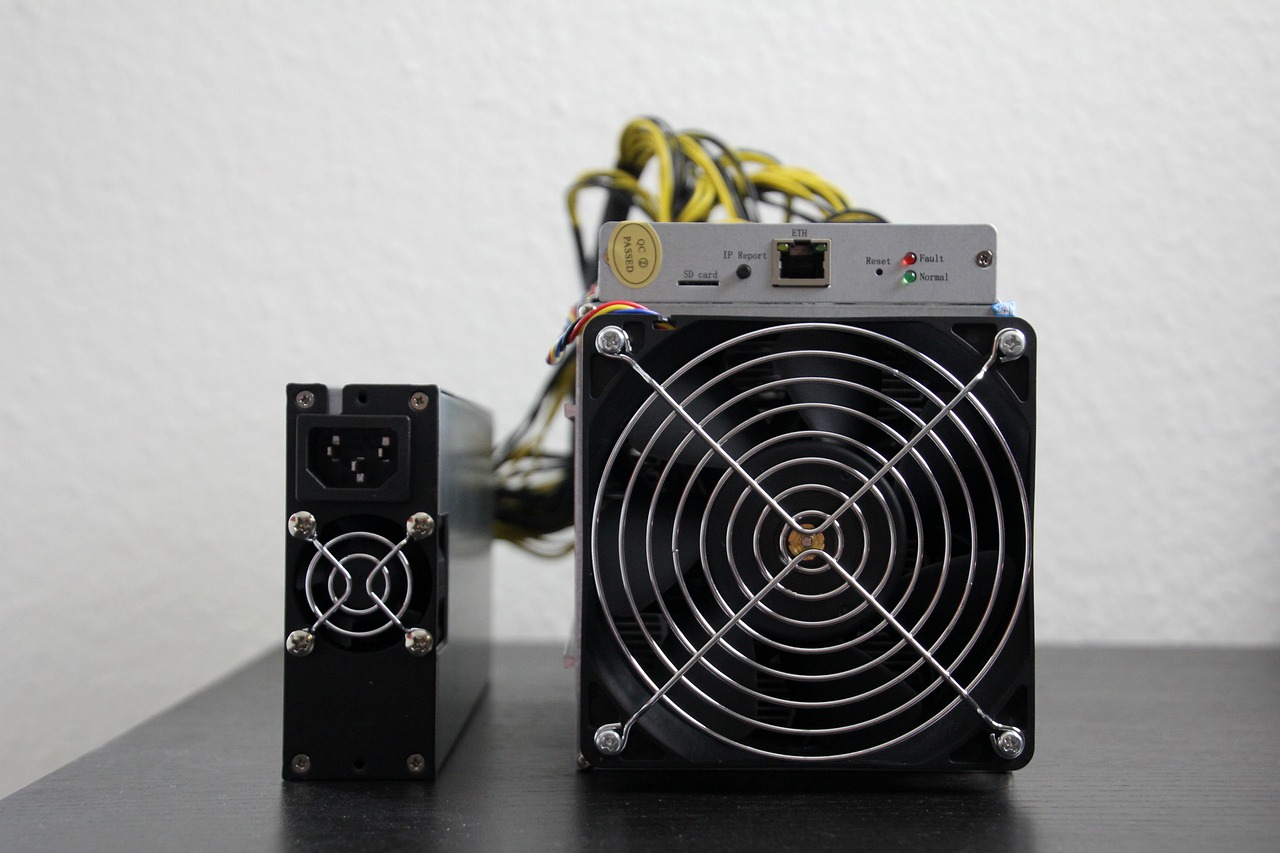
Volume Analysis
When it comes to trading in the cryptocurrency market, is a critical component that often gets overlooked. Think of trading volume as the heartbeat of the market; it indicates how alive and active a particular cryptocurrency is at any given time. Just like a doctor checks a patient’s pulse to understand their health, traders analyze volume to gauge the strength of price movements. But what exactly does this mean for you as a trader?
In simple terms, volume refers to the number of coins that have been traded during a specific period. A high volume suggests strong interest and activity, which can lead to significant price movements, while low volume often indicates a lack of interest, making price movements less reliable. For instance, imagine you’re at a concert with a crowd of thousands; the energy is electric, and you can feel the excitement. Now, picture that same concert with only a handful of people—it's just not the same, right? The same principle applies to trading volume.
To effectively analyze volume, traders often look for patterns and correlations between price and volume. Here are a few key insights:
- Price Increase with High Volume: If the price of a cryptocurrency is rising and the volume is also increasing, it indicates that the trend is likely to continue. The market is showing strong buying interest.
- Price Increase with Low Volume: Conversely, if prices are rising but volume is low, it may suggest that the trend lacks strength and could reverse.
- Price Decrease with High Volume: A significant drop in price accompanied by high volume can signal panic selling, often leading to further declines.
- Price Decrease with Low Volume: If prices are falling but volume is low, it could indicate that the market is losing interest, and the trend may not sustain.
Moreover, volume can be analyzed using various indicators. One popular method is the On-Balance Volume (OBV), which combines price and volume to show the cumulative buying and selling pressure. If the OBV is rising, it suggests that buyers are willing to step in, while a falling OBV indicates selling pressure. This indicator can be a game-changer for traders looking to make informed decisions.
Another technique is to observe volume spikes. A sudden increase in volume often precedes significant price movements. It’s like a storm brewing—when you see dark clouds gathering, you know something big is about to happen. Traders often look for these volume spikes as signals to enter or exit trades.
In conclusion, integrating volume analysis into your trading strategy can provide you with a clearer picture of market dynamics. By understanding how volume interacts with price movements, you can make more informed trading decisions and enhance your overall strategy. Remember, in the world of cryptocurrencies, knowledge is power, and volume analysis is a powerful tool in your trading arsenal.

Combining Technical Analysis with Fundamental Analysis
When it comes to navigating the often turbulent waters of the cryptocurrency market, relying solely on one type of analysis can be like sailing a ship with only one sail. To truly harness the potential of your trading strategies, it's essential to combine technical analysis with fundamental analysis. This dual approach allows you to not only understand the market's current trends but also grasp the underlying factors that influence price movements.
Technical analysis focuses on price charts and indicators, providing insights based on historical data and market sentiment. On the other hand, fundamental analysis delves into the core value of a cryptocurrency, examining factors like technology, team, market demand, and regulatory news. By integrating these two methodologies, you can develop a more robust trading strategy. Think of it like having a map and a compass; one helps you navigate the terrain while the other guides your direction.
For example, imagine you spot a bullish signal in a cryptocurrency's price chart—perhaps a breakout from a resistance level. This is where technical analysis shines. However, if you also take the time to investigate the underlying reasons behind this movement, such as a recent partnership announcement or an upgrade to the blockchain, you can confirm whether the momentum is likely to continue or if it’s just a fleeting spike. This holistic view can significantly enhance your decision-making process.
To effectively combine these analyses, consider the following steps:
- Stay Informed: Regularly check for news updates, regulatory changes, and technological advancements related to cryptocurrencies.
- Use Both Charts and News: While analyzing charts for patterns and signals, keep an eye on fundamental indicators like market cap, trading volume, and news sentiment.
- Evaluate Market Sentiment: Tools like social media sentiment analysis can provide insights into how traders feel about a particular cryptocurrency, which can complement your technical findings.
Incorporating these elements can help you avoid the common pitfall of making decisions based solely on price movements without understanding the bigger picture. Additionally, it allows you to identify potential entry and exit points more effectively. For instance, if technical analysis suggests a potential upward trend but fundamental analysis indicates negative news, it might be wise to wait for a more favorable scenario before entering a trade.
Ultimately, the combination of technical and fundamental analysis creates a more comprehensive framework for trading. By understanding both the “what” and the “why” behind market movements, you equip yourself with the knowledge needed to make informed decisions. It's like being a detective—you gather clues from both the charts and the news to piece together the story of the market, leading you to more successful trading outcomes.
As you develop your trading strategy, remember that the goal is to create a balanced approach. Relying too heavily on one analysis might lead to missed opportunities or unexpected losses. By weaving together these two methodologies, you can enhance your trading acumen and navigate the cryptocurrency market with confidence.
Q1: Can I rely solely on technical analysis for trading cryptocurrencies?
A1: While technical analysis is a powerful tool, it’s best to use it in conjunction with fundamental analysis to gain a complete understanding of market dynamics.
Q2: How can I keep up with fundamental news in the crypto space?
A2: Follow reputable news sources, subscribe to cryptocurrency newsletters, and engage with community forums to stay updated on the latest developments.
Q3: What are some common fundamental indicators to watch?
A3: Key indicators include market capitalization, trading volume, project updates, partnerships, and regulatory news.

Developing a Trading Strategy
Creating a robust trading strategy is vital for navigating the unpredictable waters of the cryptocurrency market. Think of it like crafting a map before embarking on a journey; without it, you might find yourself lost in a sea of price fluctuations and market noise. The first step in developing your strategy is to clearly define your trading goals. Are you looking to make quick profits through day trading, or are you more interested in long-term investments? Understanding your objectives will help shape the rest of your strategy.
Next, it’s essential to incorporate technical analysis into your trading plan. This means using the indicators we discussed earlier, like moving averages and the RSI, to gauge market trends. For instance, if you notice that the price of a cryptocurrency is consistently above its moving average, it might indicate a bullish trend, suggesting that it’s a good time to enter a trade. On the flip side, if the price dips below the moving average, it could be a signal to exit a position. The key is to remain consistent in applying these indicators and not to jump to conclusions based solely on short-term price movements.
Another crucial aspect of your trading strategy is risk management. This is where many traders falter, often letting emotions dictate their decisions. Establishing a clear set of rules around how much you’re willing to risk on each trade can help mitigate potential losses. For example, you might decide to risk no more than 2% of your total trading capital on a single trade. This way, even if a few trades go south, your overall portfolio remains intact. A simple table can illustrate this concept:
| Trade | Risk Amount (2% of Capital) | Potential Loss |
|---|---|---|
| Trade 1 | $20 | Loss: $20 |
| Trade 2 | $20 | Loss: $20 |
| Trade 3 | $20 | Loss: $20 |
Moreover, consider diversifying your portfolio. Just like you wouldn’t put all your eggs in one basket, spreading your investments across different cryptocurrencies can help cushion against market volatility. This approach allows you to capture gains from various sources while minimizing risk. However, be cautious; diversification doesn’t mean overextending yourself. Stick to a manageable number of assets that you can effectively monitor and analyze.
Finally, keep a trading journal. Recording your trades, including the reasoning behind each decision and the outcomes, can provide invaluable insights over time. You’ll be able to identify patterns in your trading behavior, learn from your mistakes, and refine your strategy. Remember, trading is a journey of continuous learning. If you stumble, don’t be discouraged; instead, use those experiences to grow and adapt your strategy.
In conclusion, developing a trading strategy is not a one-size-fits-all process. It requires a blend of technical analysis, risk management, diversification, and self-reflection. By taking the time to craft a personalized trading plan, you’re setting yourself up for a more informed and potentially successful trading experience in the ever-evolving cryptocurrency market.
- What is a trading strategy? A trading strategy is a set of rules and guidelines that traders follow to make informed decisions about buying and selling assets.
- Why is risk management important? Risk management helps protect your capital from significant losses, ensuring that you can continue trading even after a few unfavorable trades.
- How often should I review my trading strategy? It's advisable to review your trading strategy regularly, especially after significant market changes or personal trading experiences.

Common Mistakes to Avoid
When diving into the world of cryptocurrency trading, it’s easy to get caught up in the excitement and make some critical mistakes that can derail your efforts. One of the biggest pitfalls is overtrading. Picture this: you see a slight uptick in a coin’s price, and your adrenaline kicks in. You jump in, only to find out that the surge was momentary. Overtrading can lead to increased fees and diminished returns, so it’s essential to maintain a level head and stick to your strategy.
Another common error is ignoring stop-loss orders. These handy tools are designed to protect your investments by automatically selling your assets when they hit a certain price. Failing to use them can result in significant losses, especially in the volatile crypto market. Always remember, it’s not just about making profits; it’s also about minimizing losses.
Additionally, many traders fall into the trap of following the crowd. Social media and online forums can be buzzing with hype about a particular coin, and while it might be tempting to jump on the bandwagon, remember that not every popular trend is a good investment. Conduct your own research and analysis before making any decisions. After all, just because everyone is excited about a coin doesn’t mean it’s a sound investment.
Furthermore, neglecting fundamental analysis can be a significant oversight. Technical analysis is crucial, but understanding the underlying factors that affect a cryptocurrency's value is equally important. This includes keeping an eye on news, regulations, and technological developments within the crypto space. Ignoring these elements can lead to misguided trading decisions.
Lastly, emotional trading can be detrimental. It’s natural to feel a rush of emotions when prices fluctuate, but allowing fear or greed to dictate your trades can lead to impulsive decisions. Establishing a solid trading plan and adhering to it can help you avoid these emotional traps. Consider using a trading journal to track your trades and the emotions behind them; this can provide valuable insights and help you refine your strategy over time.
In summary, avoiding these common mistakes can significantly enhance your trading experience. Stay disciplined, keep emotions in check, and always do your homework. By doing so, you’ll set yourself up for a more successful journey in the thrilling world of cryptocurrency trading.
Here are some common questions that traders often have:
- What is the best way to start trading cryptocurrencies? Start by educating yourself about the market, choosing a reliable exchange, and practicing with small amounts.
- How can I minimize my trading risks? Use stop-loss orders, diversify your portfolio, and avoid investing more than you can afford to lose.
- Is technical analysis enough for successful trading? While technical analysis is essential, combining it with fundamental analysis provides a more comprehensive view of the market.
- What are the signs of a market reversal? Look for specific chart patterns, significant changes in trading volume, and divergences in indicators like the RSI.
Frequently Asked Questions
- What is technical analysis in cryptocurrency trading?
Technical analysis is a method used to evaluate and forecast the future price movements of cryptocurrencies by analyzing past price data and trading volumes. It helps traders make informed decisions based on patterns and trends observed in the market.
- How do moving averages work?
Moving averages are indicators that smooth out price data to identify trends over time. By averaging prices over a specific period, traders can spot potential shifts in market direction. The Simple Moving Average (SMA) and Exponential Moving Average (EMA) are two popular types, each with its unique advantages.
- What is the Relative Strength Index (RSI)?
The RSI is a momentum oscillator that measures the speed and change of price movements. It ranges from 0 to 100 and helps traders identify overbought or oversold conditions, giving insights into potential price reversals.
- What are some common chart patterns to watch for?
Common chart patterns include head and shoulders, triangles, and flags. Each pattern provides clues about potential future price movements, helping traders make strategic decisions based on historical behavior.
- How does volume analysis enhance trading decisions?
Volume analysis helps traders understand the strength behind price movements. A significant increase in volume can indicate strong buying or selling pressure, providing clues about the sustainability of a trend and helping traders confirm their analysis.
- Can I combine technical analysis with fundamental analysis?
Absolutely! Combining technical and fundamental analysis offers a more comprehensive view of the market. While technical analysis focuses on price movements, fundamental analysis looks at the underlying factors that drive those prices, such as news or economic indicators.
- What are some common mistakes to avoid in technical analysis?
Common pitfalls include relying too heavily on one indicator, ignoring market news, and failing to adapt to changing market conditions. Being aware of these mistakes can help traders refine their strategies and improve their overall trading performance.
- How can I develop a personalized trading strategy?
To create a personalized trading strategy, start by identifying your goals, risk tolerance, and preferred trading style. Then, incorporate technical analysis tools and indicators that align with your approach, and continuously adjust your strategy based on market trends and personal experiences.


